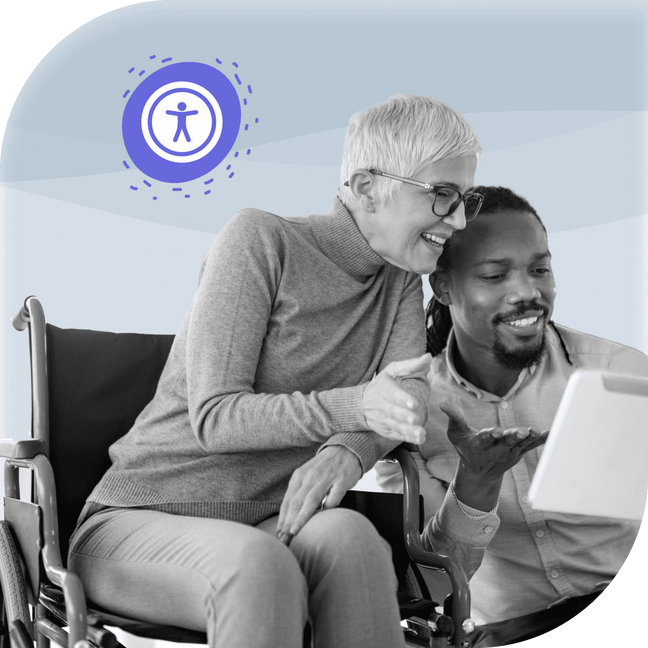Accessibility
Written by
Tiffany ClarkAbout the Author
Tiffany is an experienced workforce development expert with extensive experience in the public sector, course development, and online learning.
Reviewed by
VidCruiter Editorial TeamAbout the Reviewer
The VidCruiter Editorial Team offers practical recruitment advice, drawing on insights from seasoned professionals. Our award-winning content, supported by industry specialists, underscores VidCruiter's dedication to innovation in recruitment.
Last Modified
Apr 17, 2024
Accessibility
Accessibility is a term that refers to the ease with which employees, stakeholders, customers, and other people access a company’s facilities, services, opportunities, products, or functions. Accessibility is the practice of ensuring that work environments, job duties, and communication tools can be accessed by persons with disabilities.
The Americans with Disabilities Act of 1990 (ADA) requires that employers provide reasonable accommodations for people with disabilities. Additionally, accessibility is important to consider for customer interactions.
The ADA is divided into five sections relating to different areas of public life.
-
Title I - Employment: Defines disability, requires organizations employing 15 or more employees to provide reasonable accommodations to employees or qualified applicants, establishes reasonable accommodation process guidelines
-
Title II - Public Services: State and Local Government: Requires state and local government agencies and other public entities to make activities, services, and programs accessible to people with disabilities
-
Title III - Public Accommodations and Services Operated by Private Entities: Prohibits places with public accommodations from discriminating against people with disabilities, including leased or privately owned facilities
-
Title IV - Telecommunications: Requires internet and telephone companies to provide a nationwide system of intrastate and interstate telecommunications relay services so that individuals with speech or hearing disabilities can communicate via the telephone
-
Title V - Miscellaneous Provisions: Outlines the ADA’s relationship to other laws, state immunity, and the ADA’s impact on insurance benefits and providers, illegal drug use, the prohibition against coercion and retaliation, and attorney’s fees
ADA requirements are regulated and enforced by various federal agencies.
-
Title I is enforced and regulated by the Equal Employment Opportunity Commission.
-
Titles II and III are enforced and regulated by the U.S. Department of Justice.
-
Title IV is enforced and regulated by the Federal Communication Commission.
-
Transportation (part of Title II) is enforced and regulated by the Federal Transit Administration.
Having an accessible website benefits both people with disabilities and everyone else. With an accessible online presence, organizations can increase their audience by offering accessible content in different ways and on different platforms. Accessible content has fewer constraints and is more easily enjoyed by anyone who visits a website or social media platform.
The World Wide Web Consortium (W3C) developed accessibility standards for websites, Web Content Accessibility Guidelines (WCAG) 2. W3C defines accessible content as content that everyone can use. W3 identifies four principles of accessibility for web content: perceivable, operable, understandable, and robust. WCAG has a three-tiered grading system:
-
Level A: Only accessible by some users
-
Level AA: Accessible by almost all users
-
Level AAA: Accessible by all users
Examples:
-
Location accessibility: People with disabilities need to be able to access workplaces. Considerations include making sure doorways, entrances, workspaces, and hallways have spaces that can accommodate people using canes, walkers, wheelchairs, and other mobility devices.
-
Equipment accessibility: The ADA requires reasonable accommodations be provided so that people with disabilities have the tools they need to perform their jobs. An example would be a larger computer monitor for an employee who is visually impaired.
-
Technological accessibility: Software and company websites need to be designed for easy access to people with disabilities. Website visitors need to be able to use content even if they are hearing or visually impaired. Menus should be easy to navigate, and assistive technology such as closed captioning and voice readers need to be available.
Related Terms
Americans with Disabilities Act of 1990 (ADA)
protects people with disabilities from discrimination in every area of public life, including jobs, schools, and transportation. This protection extends to public and private areas open to the general public. The purpose of the law is to ensure that people with disabilities have equal rights and opportunities.
Accessible Design
Web Content Accessibility Guidelines (WCAG)
are accessibility guidelines developed by the World Wide Web Consortium (W3C) that apply to apps, web content, publishing, tools, and emerging technologies on the internet.
Compliance
Assistive Technology (AT)